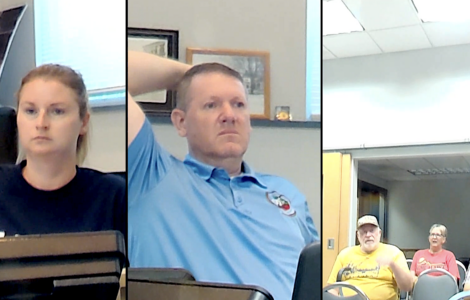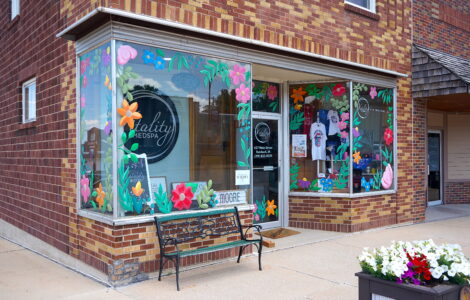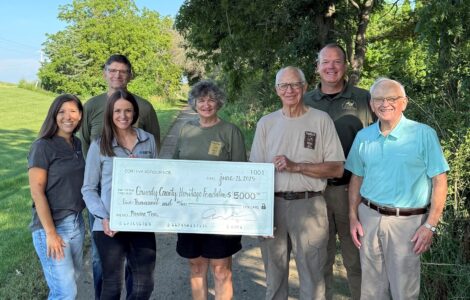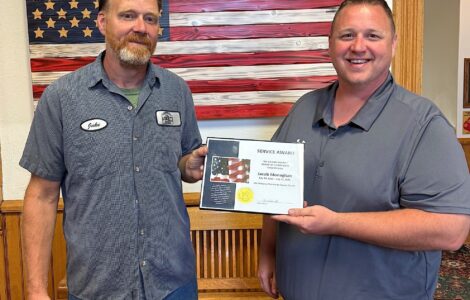Building a brighter future: community engagement shapes G-R’s path forward
Task force wraps up work, finalizes three-phase, 10-year facility plan with school board

Members of the G-R facility task force committee, the school board, and Superintendent Caleb Bonjour, back left, pictured at the completion of the committee’s work which began last winter and wrapped up earlier this month. Going forward, the district will embark on a three-phase, 10-year plan – similar to North Tama’s – which includes a bond referendum in order to, among other tasks, build new academic/classroom spaces at the middle/high school and eventually tear down the 1921 building. CONTRIBUTED PHOTO
REINBECK – In a heartwarming display of community spirit and dedication, a diverse group of 20 individuals from our small-town district came together to engage in a thorough and collaborative process aimed at shaping the future of our local schools. This group, representing various backgrounds and perspectives, embarked on a journey to review and assess the current state of our school facilities, understand the district’s financial position, and prioritize improvements that would benefit students and the broader community.
A Comprehensive Review and Hands-On Learning
The process began with an in-depth review of facility engineering assessments. These detailed reports provided a clear picture of the current condition of our school buildings, highlighting areas in need of repair or improvement. To complement this theoretical understanding, the group toured the facilities, gaining firsthand insights into the daily environments where our children learn and grow.
Understanding the financial landscape was another crucial aspect of the process. Matt Gilespie from Piper Sandler, the district’s financial consultant, provided guidance on the district’s financial position and explored various financing options. This knowledge enabled participants to make informed decisions that balance the needs of the schools with the financial realities faced by the district and individual taxpayers.
Community Insights and Prioritizing Needs
The community task force met six times over a total of 15 hours to learn, explore, and understand the needs of the district, students, and staff. They then determined the priorities and recommended projects. The options considered for facility improvements included:
-Do nothing
-Maintain two campuses
-Build a single PK-12 building on one campus (requiring new middle and high school facilities)
-Update elementary school infrastructure, including HVAC, electrical systems, and classrooms
-Provide additional space at the elementary school for PK/TK programming, special educational services, teacher/staff support areas, and small student break-out spaces
-Update and remodel the existing middle/high school facility
-Use a phased approach to build a new middle/high school facility on its current site, incorporating existing 1968 common spaces and tearing down the 1921 building
-Build a brand-new PK-12 school on a new site between Gladbrook and Reinbeck
In addition to these assessments and financial discussions, the group reviewed data from a community-wide survey. This survey gathered input from a broad cross-section of residents, ensuring that the voices of the entire community were heard and considered.
With all this information at hand, the group engaged in thoughtful discussions to identify priorities. Their focus was clear: determine what is best for students, what is most sustainable for the school district and taxpayers, and what could ultimately gain community support. These discussions were guided by a shared vision of creating a safe, supportive, and inspiring learning environment for all students.
A Plan for the Future
Through collaboration and consensus-building, the group identified the most critical improvements needed and developed a long-term facility master plan. The task force’s work culminated in two additional meetings (six hours total) with the school board to collaborate on the plan’s details. The final consensus plan was completed in Gladbrook, reflecting a unified vision shared by the communities of Reinbeck and Gladbrook – communities that have not always had a great relationship but came together to support a common goal.
A significant consensus was gained at the conclusion of the process, with all but one or two individuals having slightly different thoughts on specific details of the plan. This near-unanimous agreement underscores the effectiveness of the inclusive and transparent engagement process.
Leadership and Community Collaboration
Superintendent Caleb Bonjour, new to the district this year, has been instrumental in guiding this process. His full-time commitment to the district, unlike the shared superintendent arrangement of previous years, has brought a renewed focus on quality education and community engagement. Bonjour is dedicated to better communication between the school district and the community, working to heal past divisions and bring community members together for the benefit of students.
After a failed referendum for building improvements in 2022, the school board understood the concerns of community members and responded by partnering with SitelogIQ, a program management company specializing in K-12 education facilities. SitelogIQ provided the professional services needed, from engineering and architectural assessments to energy and operational efficiency assessments. They also facilitated open and productive community engagement to align the district’s needs with the community’s expectations.
The Long-Term Plan
The simple version of the long-term plan developed by the community task force and school board includes:
Phase I: Complete the infrastructure updates and additions to the elementary school, including a secure entryway using SAVE funding provided by the State of Iowa, which does not impact local property tax rates.
Phase II: Build new academic/classroom spaces at the middle/high school, addressing most of the task force’s priorities and eliminating the need for the existing 1921 building structure. During the transition, the original gym and auditorium will remain available. This phase requires a bond referendum for funding.
Phase III: Remove the older 1921 building structure and replace the practice gym and performance spaces. Add additional cafeteria/student commons space and larger group instructional space.
The entire project will take approximately 10 years to complete, adhering to Iowa school financing laws and keeping the project affordable for taxpayers.
Looking Ahead with Optimism
The outcomes of this engagement process are not just plans on paper; they represent a community united in its dedication to education and the well-being of its children. The collaborative spirit and shared vision of this group of twenty individuals are a testament to what can be achieved when a community comes together.
As we look to the future, there is a palpable sense of optimism and excitement. The proposed improvements and the long-term facility master plan are poised to transform our schools, providing better learning environments and enhancing the overall quality of education in our district.
This process has not only produced a roadmap for our schools’ future but has also strengthened the bonds within our community. It is a powerful reminder that when we work together, we can achieve great things.
The journey to improve our school facilities is just beginning, and with the continued support and involvement of our community, the future looks brighter than ever for our students and for all of us. Together, we are building a foundation for success that will benefit generations to come.
For more information including future town hall dates regarding a possible bond referendum, visit the district’s facility website: https://sites.google.com/gr-rebels.net/facility/home




